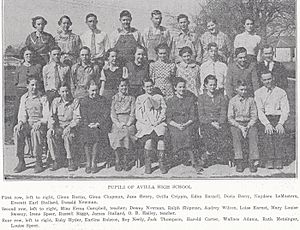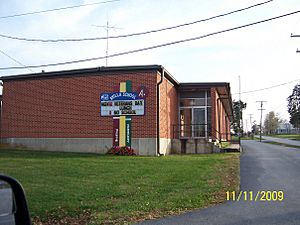Avilla, Missouri facts for kids
Quick facts for kids
Avilla, Missouri
|
|
|---|---|
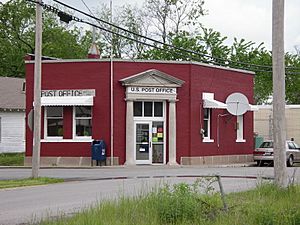
US Post Office, Avilla, Missouri
|
|
| Nicknames:
'Villa, Missoura
|
|
| Motto(s):
Panther Country
|
|
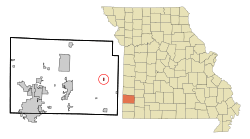
Location of Avilla, Missouri
|
|
| Country | United States |
| State | Missouri |
| County | Jasper |
| Area | |
| • Total | 0.20 sq mi (0.51 km2) |
| • Land | 0.20 sq mi (0.51 km2) |
| • Water | 0.00 sq mi (0.00 km2) |
| Elevation | 1,122 ft (342 m) |
| Population
(2020)
|
|
| • Total | 103 |
| • Density | 528.21/sq mi (203.43/km2) |
| Time zone | UTC-6 (Central (CST)) |
| • Summer (DST) | UTC-5 (CDT) |
| ZIP code |
64833
|
| Area code(s) | 417 |
| FIPS code | 29-02746 |
| GNIS feature ID | 2396581 |
Avilla is a small village in Jasper County, Missouri, United States. In 2020, 103 people lived there. It is part of the Joplin, Missouri Metropolitan Area. Avilla is one of the oldest towns in Jasper County, founded in 1856. It was officially planned and set up for public use on July 23, 1858, by Andrew L. Love and David S. Holman.
| Top - 0-9 A B C D E F G H I J K L M N O P Q R S T U V W X Y Z |
Where is Avilla Located?
Avilla is found at 37°11′38″N 94°7′44″W / 37.19389°N 94.12889°W. It is about ten miles east of Carthage, Missouri, on Missouri Route 96. This route used to be part of the famous Historic U.S. Route 66. The village is surrounded by farms, pastures, small wooded areas, and streams. White Oak Creek is nearby to the south and east. The Spring River flows about three miles to the south.
The village covers a total area of about 0.20 square miles (0.51 square kilometers), and all of it is land.
Avilla's Story: A Look Back in Time
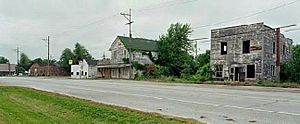
Early Days: 1831–1861
Who Started Avilla?
Pioneers came to this area in the 1830s and 1840s. They saw beautiful grasslands with forests along winding streams. Building homes on the prairies was hard, so this part of Jasper County grew slower. Early homes were made of logs, rock, or sod. Even though families lived far apart, they still helped each other. Some of the first settlers near Avilla were John K. Gibson in 1831 and James Blackwell in 1835. Nelson Knight built a farm north of Avilla in 1837. Jasper County itself was created in 1841.
The first school in the Avilla area was a one-room log cabin called White Oak School. It was built in the 1840s. Dr. Jaquillian M. Stemmons arrived in 1853 and was the first doctor in the area. The town of Avilla was founded in 1856. Andrew L. Love and David S. Holman officially planned it in 1858. Mr. Love was the first Justice of the Peace. Mr. Holman was the first merchant and postmaster, opening the post office in 1860.
Native American History
This land was once the hunting grounds of the Osage Indians. They were known to camp near the Spring River, about three miles south. Other tribes also lived here after being moved by the government. Later, all tribes were moved to other areas. However, some Native Americans might have returned or stayed. They were seen trading in Avilla and nearby towns before the Civil War.
Avilla During the Civil War

By 1861, Jasper County had several small towns. Avilla was new but busy, with over one hundred citizens. Like other towns in border states, families in Avilla had different views about the Missouri secession. Some people owned slaves. Dr. Jaquillian M. Stemmons and other town leaders supported the Union. Dr. Stemmons owned eight slaves he had inherited. He never bought or sold slaves and supported ending slavery in the United States. Avilla's views were different from nearby Sarcoxie, which supported the Confederacy.
Even though the area around Avilla was largely Confederate, the United States flag kept flying over Avilla. It was proudly raised in the town center park and guarded by the townsmen. Schools closed, and many families sent their women and children to safer places.
Civil War Years: 1861–1865
Avilla Under Attack
Dr. Jaquillian M. Stemmons, a strong Union supporter, created a group of local men called the "Avilla Home Guard." They protected their homes from roaming groups. In 1861, this group was one of the first in the area. It was mostly made of older citizens, as younger men joined regular military forces. Local people who supported the Confederacy did not like this.
On March 8, 1862, a group of over one hundred pro-Confederate fighters attacked northeast of Avilla. They surrounded Dr. Stemmons's log home. About twenty-five town militiamen and some men from Carthage were defending it. A US Cavalry officer, Captain Tanner, was also there. The attackers tried to get into the house but faced heavy gunfire. They eventually set the cabin on fire. Dr. Stemmons and Lathan Duncan, an Avilla militiaman, were killed. Several others were hurt, and two were taken prisoner.
After the house burned, the outnumbered militia left in the dark. They regrouped near Avilla's north side, ready for another attack. But the attackers left instead. Dr. Stemmons was seen as an important person who opposed the Confederacy. His brave actions, along with Mr. Duncan and the militia, likely stopped more violence and saved Avilla from being burned. Many brave militiamen defended the town that night.
A Warning to Others
The attack on Dr. Stemmons's home made the townsmen angry. Everyone in Avilla prepared to fight. The Union Army took control of Missouri in 1862. But the area around Avilla still had small groups of Confederate fighters. The town militia became the first county militia for a while, based in Avilla. They patrolled eastern Jasper and western Lawrence Counties. Union soldiers sometimes joined them. They protected the town and countryside in several small fights. Many fighters were tracked down. The Avilla "pioneer marksmen" became feared.
In one story, a skeleton was found south of town with a bullet hole in the skull. It was believed to be from a previous fight. The skull was then hung from a tree limb near the road for over a year. This was done "as a warning to all other" fighters.
Union Army in Avilla
By 1863, the Enrolled Missouri Militia was stationed in Avilla. These soldiers were led by Major Morgan. Tents were set up, and homes and barns became temporary Army barracks. Hundreds of soldiers and many refugees stayed there at different times. The town became known as "Camp Avilla." By 1864, many original town militiamen helped the new Missouri Militia. Avilla supported operations against the fighters in the region. It also served as a stop for transporting Confederate Prisoners of War. Because it was in open land, Avilla could defend itself well. It became a safe place for people from nearby towns that had been burned, like Carthage.
After the War: 1865–1900
Avilla Becomes a Boom Town
Avilla avoided being destroyed during the Civil War. It quickly became a busy town after the war ended. Goods and building materials were brought by wagon from Sedalia, Missouri, the closest railroad stop. Much of Jasper County was in ruins. Local businesses in Avilla became rich by helping to rebuild Carthage and other nearby towns. Many old residents said Avilla was the largest town in Jasper County for a short time after the war. Farmers from Kansas even came to Avilla to buy seeds and supplies.
Captain Thomas Jefferson Stemmons, a Union commander and son of Dr. J.M. Stemmons, returned home. He started a store with D. B. Rives. This was the first new business after the Civil War. The first hotel, The Avilla House, was built in 1868. By the 1870s and 1880s, Avilla had many businesses. These included general stores, grocery stores, doctor's offices, a drug store, and a stable. There were also three churches and two secret societies: the Freemasons Lodge and the Odd Fellows Lodge.
Houses appeared everywhere. The first Avilla school in town was built in the 1880s. It taught grades 1-12. Some records say the town's population was over five hundred during these years. However, the town's growth stopped because the railroad was not built through Avilla. Farming was the main resource, and without more industry, the population did not grow much after this time.
Avilla Soldiers in the Spanish–American War
In February 1898, the battleship USS Maine exploded in Cuba. This caused a strong desire for war against Spain in America. On March 4, 1898, a big war rally was held at the Avilla Methodist Church. Three lawyers gave exciting speeches, and a ladies' choir sang patriotic songs. As a result, fifty-three young men volunteered for military service. They formed a new company called the Avilla Zouaves. These units were known for their colorful uniforms and precise drills.
The Avilla youth became Company G, 5th Missouri Infantry Regiment, in the US Army. Two months later, the new Avilla unit was escorted to the Carthage Train Depot. They were sent off for battle in the Spanish–American War with music and flags. The fighting in Cuba ended quickly. The 5th Missouri Infantry was released from service on November 9, 1898. So, the Avilla Zouaves did not see any action. Even though they did not fight, this event shows the strong patriotic spirit of Avilla in 1898.

The 1900s: 1900–1970
The Bank of Avilla and a Famous Robbery
The Bank of Avilla opened on September 18, 1914. Its building was finished in 1915. Samuel Salyer was the first main owner and cashier. Mr. Ivy E. Russell became the main owner and cashier in 1919 and stayed until 1944. The small bank handled farm and business loans. It stayed profitable even during the Great Depression of the 1930s. This was amazing because almost half of America's banks closed or merged in the 1930s. The farms around Avilla made it an important farming community.
The Bank of Avilla was robbed on May 18, 1932. Members of the "Irish O'Malley Gang" robbed the bank and took the cashier. On that Wednesday, two men robbed Mr. Ivy E. Russell at gunpoint inside the bank. They then took him in their car toward Carthage, Missouri. They left him by the roadside. One of the robbers was Jack Miller, who drove the getaway car. It is not known if the money was ever found. Bank customers were not insured at this time. All members of the O'Malley Gang were eventually caught after many robberies and other crimes. Some gang members were killed, and one was sentenced to a seventy-five-year prison term for the Avilla bank robbery.
In 1938, Frank Layton and Jack Miller were stopped by police in Arkansas. They were charged with breaking a gun law because of Jack's sawed-off shotgun. This case became a famous Second Amendment case called "The Miller Case" or United States v. Miller. Jack Miller was killed one month before the Supreme Court made its decision.
Even after being robbed and taken, Mr. Ivy E. Russell continued to run the Bank of Avilla for at least twelve more years. After the robbery, Mr. Russell added more security. He kept a large gun behind the teller window. It is said that Bonnie & Clyde were near the area in Joplin, Missouri, a few months after the Avilla bank robbery. Local stories say that Clyde Barrow entered the Bank of Avilla. He saw Mr. Russell with his gun behind the teller window. Clyde supposedly tipped his hat, said "Afternoon," and left quickly. The bank always stayed open during normal hours, with Ivy E. Russell as the cashier. The Bank of Avilla was never robbed again.
As more roads were paved and travel improved, the need for a local bank lessened. Around 1944, its money was moved to the Bank of Carthage. The bank building was empty for a few years. On April 1, 1952, the government leased the property. It was used to house the old US Post Office, which needed a new place. The historic building has been a post office ever since.
Avilla on Route 66
The road through the center of Avilla was called "Old Carthage Road." It was paved and became part of U.S. Route 66 in the late 1920s. This kept businesses busy as Avilla became a stop on "The Mother Road." This was the main highway through America in those years. The town's population had already reached its highest point before the 1900s. But Avilla continued to make modern improvements. It got a volunteer fire department, a hardware store, a barbershop, a beauty salon, and a tavern. There was also The Avilla Cafe, several auto service stations, and repair shops.
A larger school building was also built. The old one-room school houses in Jasper County were combined and moved to Avilla. The teachers from these country schools formed the elementary/middle school Avilla R-13 School District. The Avilla school became the only one in the district. Since the school teaches kindergarten through eighth grade, high school students went to nearby towns like Carthage, Sarcoxie, or Jasper.
Avilla Today: 1970 – Present
A "Living Ghost Town"
Avilla started to shrink in the 1940s after World War II. More people, especially young adults, moved to bigger cities for jobs. The biggest change happened in the 1960s. US Route 66 was replaced by I-44. This meant less traffic and fewer customers for businesses. Many remaining businesses failed or moved in the 1970s. In 1971, a large fire at the Avilla lumberyard destroyed several buildings. The lumberyard was rebuilt, but by the late 1970s, many town shops were empty. Only businesses that could be supported by the small local population and farms survived. Most of the oldest buildings are now gone, leaving empty spaces. US Route 66 was renamed Missouri Route 96 in 1985. By then, Avilla was already a small, quiet rural community, much like it is today. Few old buildings remain as reminders of the town's busy past.
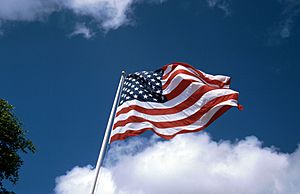
Avilla is called one of the "living ghost towns of old Route 66." It was never completely abandoned and is still a village today. Many old country homes and farmhouses are seen around Avilla. Old family traditions in farming and raising animals continue in the area. The community is currently restoring the Avilla Saddle Club Arena. You can still see some old buildings, like the 19th-century Avilla (United) Methodist Church. This was the first church in Avilla. An old store building from the Civil War era also remains near the old park. Even though it has faced threats of closing, visitors and residents today can enjoy the old 1915 bank building. It still has the old teller windows and vault. This historic building continues to fly Old Glory and serves as Avilla's US Post Office.
The Bank of Avilla was added to the National Register of Historic Places in 2022.
Who Are Some Famous People from Avilla?
- Homer L. Hall is an award-winning journalist, educator, and author. He wrote many textbooks, including High School Journalism. He grew up on a farm near Avilla and graduated from Carthage High School in 1956. He is in the Missouri Interscholastic Press Association Hall of Fame and the National Scholastic Journalism Hall of Fame.
- James M. Craven was a state representative of Missouri from Avilla. He was born in Indiana in 1831. He became a livestock dealer in California and Oregon in the 1850s. He moved to Avilla and entered politics in 1866.
- Walter Stemmons was a journalism professor and editor at the University of Connecticut. He was born in Avilla in 1884.
Why is it Called Avilla?
It is known that Avilla, Missouri, was named by 1858 because of official documents. But who chose the name and why is still a mystery. The town was founded by Andrew L. Love and David S. Holman. They were merchants and landowners who wanted to sell goods and property in the mid-1850s. However, they did not record much information about themselves or their choices. The real reason for the name might be in an old document or letter that has not been found yet. The knowledge might have been lost with the founders. There are other places in the United States with similar names, like a town in Indiana and a community in Arkansas.
A story that Avilla, Missouri, was named after Avilla, Indiana, started in 1930. This was published in a university paper. However, the Indiana town was named seventeen years after the Missouri town, in 1875. Before that, Avilla, Indiana, was known as “Hill Town.”
How Many People Live in Avilla?
| Historical population | |||
|---|---|---|---|
| Census | Pop. | %± | |
| 1930 | 165 | — | |
| 1940 | 178 | 7.9% | |
| 1950 | 142 | −20.2% | |
| 1960 | 174 | 22.5% | |
| 1970 | 119 | −31.6% | |
| 1980 | 151 | 26.9% | |
| 1990 | 99 | −34.4% | |
| 2000 | 137 | 38.4% | |
| 2010 | 126 | −8.0% | |
| 2020 | 103 | −18.3% | |
| U.S. Decennial Census | |||
Avilla's Population in 2010
In 2010, there were 125 people living in Avilla. There were 44 households and 35 families. The village had about 625 people per square mile (241 people per square kilometer). There were 54 housing units. Most residents (90.4%) were White. About 2.4% were Native American, and 7.2% were from two or more races. About 4.8% of the population was Hispanic or Latino.
In the households, 43.2% had children under 18. Most (63.6%) were married couples. The average household had 2.84 people, and the average family had 3.00 people. The average age in the village was 38.5 years. About 28.8% of residents were under 18.
Local Legends and Ghost Stories
The legend of the “Avilla Phantom Bushwhacker,” also known as "Rotten Johnny Reb," is a lasting Avilla ghost story. It describes hauntings involving the ghost of a dead Confederate fighter. His remains were never properly buried. An old tree is also part of the legend. It is said to have dark energy after his skull was hung on it. According to one version of the legend, the phantom is looking for his head and wants revenge on the town's people.
See also
 In Spanish: Avilla (Misuri) para niños
In Spanish: Avilla (Misuri) para niños
Images for kids
-
Flying steadfast over Avilla, 33 stars graced Old Glory at the onset of the American Civil War. Town leaders were Unconditional Unionists and remained aligned with newly elected president Abraham Lincoln throughout the Civil War tragedy.


